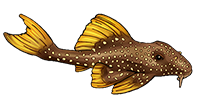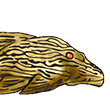| Scientific Name | Pseudacanthicus sp. (L427) |
| Common Names | L427, Jatupu Cactus Pleco Jatupu-kaktussugemalle (Denmark) |
| Pronunciation | SUE dah KAN thi cuss |
| Etymology | Pseud- Greek: False, Acanthicus - Greek: Spiny, Thorny. Literally "False Acanthicus" referring to this genus being similar to, yet different from, Acanthicus. |
| Identification | The German common name for this genus is ''Cactus Pleco''. A good name! Pseudacanthicus is a member of the Acanthicus clade. Species of the Acanthicus clade are distinguished from other Loricariidae species by the presence of (1) longitudinal rows of keels (pointed odontodes) along the body sides; (2) eight or more dorsal-fin rays (vs. six or seven in most other loricariids except Pterygoplichthys, Chaetostoma, Pogonopoma and Pseudancistrus pectegenitor); (3) seven to eight infraorbitals (vs. usually five or six); (4) five anal-fin branched rays (vs. usually four); and (5) presence of hypertrophied odontodes along the snout margin (vs. hypertrophied odontodes absent in other loricariids except Isbrueckerichthys and Pareiorhaphis, in Neoplecostominae; Panaque and Pseudancistrus and Neblinichthys, in Ancistrini; and most dimorphic males of Loricariinae). Within the Acanthicus group, Pseudacanthicus is distinguished by the presence of two small plates in the posterior area of the compound pterotic (vs. one median plate or plate absent), and by the presence of narrow premaxillae with a small number of elongate and curved teeth (except from Leporacanthicus). |
| Distribution | Rio Jatapu, Amazonas state, Brazil Amazon, Lower Amazon, Uatumã, Jatapu (click on these areas to find other species found there) Login to view the map. |
| Feeding | Carnivore although not a predator, prawns and chopped mussel appear favorites and promote favorable growth. High quality pellet foods are well received and greatly reduces the volume of waste produced. Some vegetable should also be provided and thus balances diet. User data. |
| Furniture | Adequate coverage for this Genus is required. Multiple structures consisting of wood, caves, and overhangs are ideal. High intensity lighting does not bother them and many species will 'sun themselves' on the top of the furnishings if they are comfortable with their environment. Long sight lines can promote aggression. Placing structure at different distances from the front glass is an effective solution. |
| Suggested Tankmates | The temptation with large tough Loricariids is to keep them with other large tough fish such as Oscars or other brutish characters. This actually works quite well with most omnivorous or mainly vegetarian plecos. Pseudacanthicus despite their defensive protection can be bullied by faster moving fish of similar size. They are carnivores and only eat vegetables when their preferred food is unavailable. The amount of waste produced depends on their diet but is considerably less than a Panaque or Pterygoplichthys of similar size. |
| Breeding | Unreported. |
| Breeding Reports | There is but a single breeding report, read it here. |
| Registered Keepers | There are 12 registered keepers, view all "my cats" data. |
| Wishlists | Love this species? Click the heart to add it to your wish list. There are 3 wishes to keep this species, see who wants what. |
| Spotters | Spotted this species somewhere? Click the binoculars! There are 9 records of this fish being seen, view them all. |
| Forum BBCode | |
| Search for P. sp. (L427) | |
| Look up P. sp. (L427) on AquaticRepublic.com | |
| LFS label creator ARN ref:1.4.40.2885 | |
| Last Update | 2022 Jan 22 09:36 (species record created: 2011 Jan 10 16:11) |





/siluriformes/loricariidae/pseudacanthicus/sp%28l427%29/1.jpg)
/siluriformes/loricariidae/pseudacanthicus/sp%28l427%29/2.jpg)
/siluriformes/loricariidae/pseudacanthicus/sp%28l427%29/3.jpg)
/siluriformes/loricariidae/pseudacanthicus/sp%28l427%29/4.jpg)
/siluriformes/loricariidae/pseudacanthicus/sp%28l427%29/5.jpg)
/siluriformes/loricariidae/pseudacanthicus/sp%28l427%29/6.jpg)